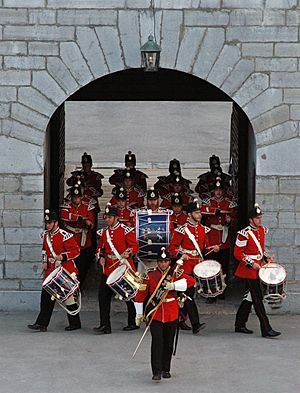Fort Henry Guard facts for kids
Quick facts for kids The Fort Henry Guard |
|
|---|---|

Fort Henry Guard Drums
|
|
| Active | 1938-Present |
| Country | |
| Branch | Civilian Exhibition Drill |
| Type | Line Infantry |
| Size | Two Sub-Units |
| Garrison/HQ | Fort Henry |
| Motto(s) | Merentur Etiam (We also serve) |
| March | Quick March: British Grenadiers Slow March: The Maple Leaf Forever |
| Mascot(s) | David the XIIth |
| Commanders | |
| Honorary Guard Commander | Hon. Hugh Segal OC OOnt CDSen |
The Fort Henry Guard (FHG) is a special group that brings history to life. They are based at Fort Henry, a famous national historic site in Kingston, Ontario, Canada. Since 1938, they have shown what life was like for British soldiers long ago.
The Guard acts out scenes from the British Army during the time of Queen Victoria. This was when Canada was part of the British Empire. They perform old military drills, like daily inspections and cannon firings. They also have big garrison parades and weekly Sunset Ceremonies. Guard members wear uniforms like those of British soldiers and gunners from 1867.
Most members of the Fort Henry Guard are university, college, and high school students. They are a civilian group, meaning they are not part of the Canadian Forces. The Guard performs and offers fun history programs from May to October each year.
Contents
History of the Fort Henry Guard
The Fort Henry Guard started in 1938. Ronald L. Way founded the group after Fort Henry was rebuilt. This restoration was part of a government program during the Great Depression.
During the Second World War, the fort was used as a camp for prisoners of war. The Guard stopped performing then, and many original members went to serve overseas. Fort Henry reopened as a living museum in 1948. The Fort Henry Guard has been there every summer since.
Famous Performances and Visitors
The Guard has performed at many events in Canada and other countries. One famous event was the Royal Tournament in England. They also performed with the United States Marine Drum and Bugle Corps in Washington D.C. and at Fort Henry.
Each year, the Guard performs the 1812 Overture with the Kingston Symphony. This show is special because it combines music with real artillery fire. Important visitors like Elizabeth II and Prince Philip have enjoyed the Fort Henry Guard's performances.
The Guard's special flags, called Colours, follow the rules from 1867. They were given to the Guard in 1955 and are carried in parades. These flags honor the 33 British and 6 Canadian regiments that were once stationed at Fort Henry. The Guard today carries on the pride and traditions of these old military groups.
How the Guard is Organized
The most important leader of the Guard is the Guard Captain. This person is in charge of all training and performances. The Artillery Lieutenant is second in command and manages the fort's cannons.
There are also two Ensigns. They carry the Regimental Colours during parades. They also teach new staff about the fort's history and help run the daily activities.
The Guard has two main groups:
- The Drill Squad is a team that performs precise drills. It is led by the Serjeant Major and a Colour Serjeant.
- The Drums are a marching unit that plays snare drums, bass drums, fifes, and bugles. They are led by the Drum Major and a Drum Serjeant.
Other roles include an Adjutant, a Brigade Sergeant Major, and several junior non-commissioned officers. These officers help train and supervise the new members, called privates. Everyone in the Guard, even the Guard Captain, starts as a private.
The Guard also has interpreters who show what daily life was like. There are also pipers, Pioneers, and the Goat Major. The Goat Major takes care of David XII, a White Saanen Goat who is the Guard's mascot. All Guard members learn to operate the fort's cannons while wearing Royal Artillery uniforms.
Equipment Used by the Guard
The Fort Henry Guard is known for being very accurate with history. Their uniforms are exact copies of the ones worn in the 1860s. The Snider-Enfield rifles and carbines they use are also real weapons from the 1860s.
The Guard fires several types of historic cannons:
- 24-pounder smooth bore muzzle loading guns
- Three rifled breech loader 6- and 12-pounder Armstrong guns
- 32-pounder carronades
- Mortars

